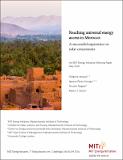| dc.description.abstract | Ten years after the conclusion of its universal energy access program, Morocco has now become one of the best examples of successful integrated utility-led electrification programs. In less than fifteen years, rural electrification rates in the kingdom skyrocketed from a bottom low of 18% in 1990 to nearly 100% presently. Around 10% of the country’s population, or 200,000 households living in remote rural areas, were electrified through solar home systems. Morocco is currently Africa’s only success story in scaling up solar-driven electrification programs wherever grid extension programs were not feasible—not a small feat when one considers that it was not until the late 2000s that solar finally gained traction continent-wide with the emergence of so-called “pay-as-you-go” business models.
Three key factors have underpinned the dramatic success of the Moroccan experience with solar. First, a strong political support in favor of solar systems, which translated into ambitious agendas and adequate public resources to achieve government objectives. Second, the ability of local stakeholders to design and implement solar concessions and attract capable international solar developers on the basis of extensive pre-feasibility analyses that match demand estimates with various possible supply options through solar systems. Third, the ability of the national utility and solar concessionaires to leverage all possible sources of funding available for energy access around a transparent and financially sustainable private sector-driven model, from cross-subsidies to direct public subsidies and international debt.
The Moroccan case demonstrates that solar systems hold potential in closing the electrification gap and electrifying the last percent of unelectrified households on reasonable financial terms. However, several factors call for prudence as one may be tempted to generalize key success factors for universal energy access in African contexts. Morocco started out with a rural electrification level which was far below those of its comparable neighboring countries. It had—and seized—the opportunity to exploit a high level of cross-subsidization from urban consumers and greatly benefited from an economic development level far exceeding that of most Sub-Saharan African countries. While the Moroccan experience may then well confirm the potential of solar to reach universal energy access, it seems important not to relate the dramatic increase in electrification to the implementation model alone and to rather contextualize the Moroccan experience in the light of the specific challenges that faced the country throughout its electrification process. | en_US |
